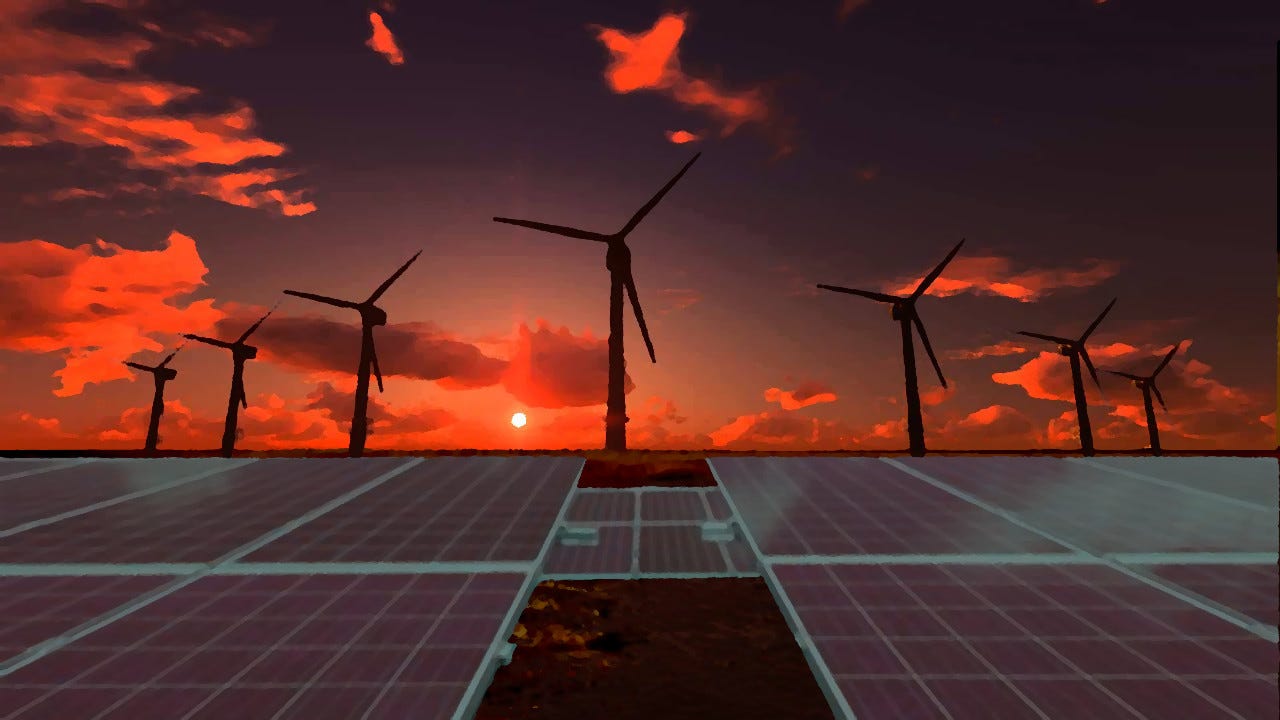Beneath the Artificial Earth
Beneath the Artificial Earth
Electricity generation, economic doctrine, and the ever-growing power demands of AI
“You never change things by fighting the existing reality. To change something, build a new model that makes the existing model obsolete.” - R. Buckminster Fuller
In one of the merely possible futures within reach of our imagination, our planet possesses unimaginable computational power harnessed by Artificial Intelligence. These colossal computational contraptions can calculate protein folds so effectively, that they can predict the side effects of new drugs with only moderate inaccuracy, while mediocre television shows are so cheap to generate that even the most undiscerning viewer is bored of them. To power these computational achievements, the landscape is cloaked in vast continental sheets of light farms, ringed by endless rows of windmills, and peppered with catalytic carbon dioxide stations to compensate for the scarcity of trees. This is the Artificial Earth.
The grim truth of the current obsession with AI is that computational power requires energy, and ‘green’ energy requires land. Both these demands are pulled forward by economic doctrine, since the new is always profitable, whether or not it is helpful or desirable. The perpetual motion machine of venture capital unavoidably favours the globally lucrative over the merely good. Driven onwards by their profit-making and subsidy-sucking potential, we are advancing both of these questionable agendas.
For those that have metaphysical faith in perpetual economic growth, ‘green’ energy is a waste of time because nuclear power is a quicker fix, and hey, nuclear waste can simply be buried for tens of thousands of years - it will probably outlast our species, the cynic might say, so why worry about it? For those paralysed with climate terror, we are weirdly obligated to destroy our environment to build ‘green’ energy, even though China’s coal emissions exceed the entirety of the West’s carbon emissions and thus nothing we do domestically will make much difference to the atmosphere. Economics has already poisoned environmentalism beyond recognition.
Collisions between economic doctrine and moral panic are seldom beneficial. International treaties to restrict energy production are deemed wildly unfair to so-called ‘developing’ nations, because they supposedly missed out on industrialisation. We seem incapable of imagining futures whereby the ‘developed’ nations serve as a warning for just how miserable the aftermath of industrialisation can become. In part, it is the billionaire dragon-hoards that are the problem here, for those who possess them must endlessly encroach upon ‘new markets’. In the pantomime that is technological manufacturing, late arrivals reap little benefit at great costs while true believers dare not question the impact of the shiny and new.
That which we laughably call ‘green energy’ might contribute to a viable imagined future, provided we were willing to build the global electrical grid proposed by R. Buckminster Fuller. The chief problem with wind and solar - that they cannot produce power on demand - could be resolved by exchanging electricity between all nations. But as Fuller discovered, the trouble with this plan is that a shared planetary infrastructure for power-sharing would require making war obsolete. This tacitly violates economic doctrine, for there are such vast profits to be made in the sale of destructive weaponry that Fuller’s proposal has stalled into a mere pipe dream.
Yet even Fuller’s grid cannot save us from the threat of the Artificial Earth. For even if we are sharing power - in some cases, especially if we are doing so! - nations are invited to pave over their natural landscape to build light farms and windmill foundations, and to poison the soil seizing the rare elements required for constructing megabatteries. The greater our greed for power grows, the greater the encroachment of the Artificial Earth. Lust for the stars will doom our living planet just as effectively as nuclear annihilation. Every technology that has ever-growing power needs eventually becomes an abomination, and Artificial Intelligence is perhaps the most hilarious excuse for destroying the environment yet conceived.
In that merely possible future where these insanities have been given full reign, there are far fewer species, and those that survive eke out a miserable existence among the concrete, steel, and glass, having no memory of what was extinguished in our lust for electrical and computational power. Yet beneath the Artificial Earth, the land that belongs to us all still lies sleeping. Upon its soil we might yet grow a future worth sharing, not only with each other, but with the beasts and the birds, the trees and the flowers, and all those bright and wonderous things that have blessed each of the many ages of our planet.
Source: Stranger Worlds

Comments
Post a Comment